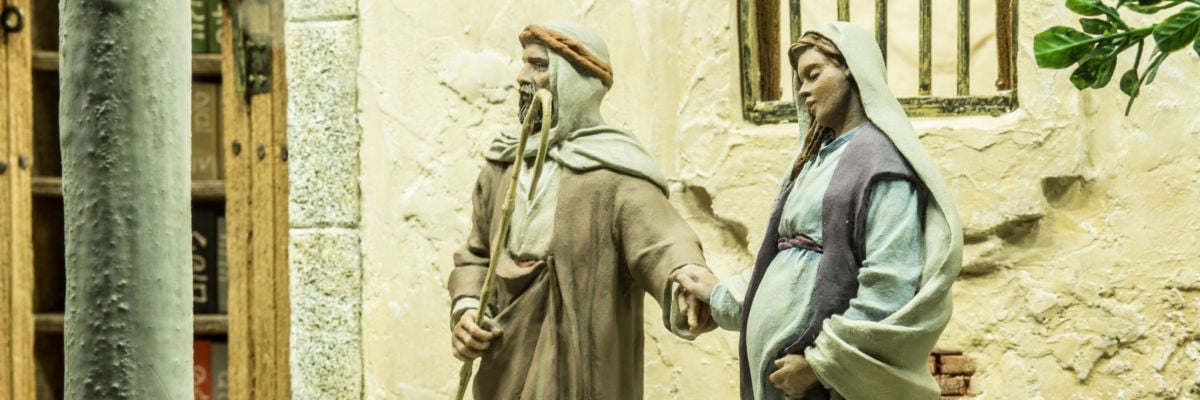
During the holy season of Advent, themes of “anticipation” and “expectation” capture the feeling of eagerness to celebrate Jesus’s birth at Christmas. Since the joy of awaiting her son is the original Advent, Mary’s pregnancy is a wonderful meditation to accompany this holy time of expectation.
Centuries of preparation by way of prefigurements and prophecies offer undeniable testimony to the holiness of the Incarnation. Yet the way of this fallen world often sees unendurable suffering intertwined with the greatest goods. Mary’s joy and suffering are similarly intertwined.
Jesus’ conception is a divine encounter between a virtuous Jewish maiden and Almighty God. Mary receives an angel on God’s behalf, who invites her to be the Mother of the Redeemer. When she accepts the proposal, immediately Mary is overshadowed by the power of the Holy Spirit. This crucial event will become a miracle for all time, yet the initial moment of the Incarnation is perfectly and profoundly protected in quiet, tender privacy between Mary and the origin of all creation.
Mary had been betrothed formally to Joseph in a betrothal ceremony known as kiddushin, after which she accepted God’s proposal to bear his Son. When Joseph realized that Mary was pregnant, he offered to release Mary from their betrothal before the ceremony of nisuin, as this chaste man knew he was not the child’s father. The reason Joseph offered to release Mary was that he recognized that Mary had been called to a holy function, like the Ark of the Covenant in the Old Testament. She had become the new Ark.
As a Jewish man, Joseph knew that in Exodus, the Lord gave Moses the Ten Commandments, the Law, his word. To show the importance of the Law as the key to all happiness and eternal life, God instructs the Israelites specifically about how to carry the Tablets of the Law in an ark of the Covenant. The ark must be of acacia wood, with measurements of a given amount of cubits, covered in gold, with golden loops, and with gold-covered wooden acacia rods used for transportation. No one is allowed to touch the ark, and it abides in the Holy of Holies (37:1-25).
The ark is also a symbol for Mary. Mary becomes the personal ark, who contains within herself the living Word of God. Like the original Ark of the Covenant, Mary is the vessel whom God carefully prepares. She is immaculately conceived, allowing Jesus to draw life from a holy womb. Thus, Jesus’ own spotless human body may be a perfect human sacrifice, the lamb without blemish, to atone for Adam’s sin.
With profound admiration, Joseph considers himself unworthy to marry and take care of Mary. He would have known that Uzziah died when he dared to touch the ark (2 Sam. 6:7). Joseph understood that Mary was now set apart as a holy vessel. This is why the angel must tell Joseph, “Do not be afraid to take Mary as your wife: for that which is conceived in her is of the Holy Ghost” (Matt. 1:20). God wanted worthy Joseph to protect and care for her.
Because of her pregnancy, Mary anticipates both her own child’s arrival and the prophesied Messiah. Mary is poignantly at the center of the story of sin and redemption. Jesus’ arrival is certainly the most intricately woven, carefully crafted, lovingly nurtured, and profound story ever told.
Jesus Christ is furled within Mary’s womb. His tiny embryonic self is enfolded into a miniature particle of living, material immortality. God and man wrap up into one within her. All of salvation history relies on these few tiny cells, multiplying quietly within Mary.
For many mothers, the feeling of holding a life within is exciting, especially with a first child. Everything is new! A woman’s body stretches and grows in strange and uncomfortable ways. As with any new mother, surely Mary’s thoughts simultaneously expanded.
Likely, Mary thought about where the baby would sleep. She prepared blankets. She wove swaddling clothes. She may have thought about what the baby would look like, and how she and Joseph would educate him in the scriptures. Mary must have been anticipating the natural details that surround any human birth.
At the same time, Mary was also thinking about others. She visited her pregnant cousin, Elizabeth, who cried with joy, “Blessed am I that the mother of my Lord should come to me!” Joy is a fruit of the union of the divine in the earthly. Like David dancing before the ark, John leaped in his mother’s womb. Mary responded to Elizabeth, “My soul magnifies the Lord, and my spirit rejoices in God, my Savior!”
The friendship between Mary and Elizabeth is a gift and a blessing. Friendship is an important source of strength when trials and difficulties arise. We draw strength and courage from our time with friends, sharing ourselves in conversation and activity with people we trust. Mary did not know what difficulties would lie ahead for her, but she was given three months to create memories she could draw upon when her troubles came. When evil intentions surrounded her son, Mary could hear Elizabeth in her memory saying that she had been “blessed” by Mary’s presence, which may have been a great consolation.
At the time, Caesar Augustus insisted that everyone return to their fatherland for a census, so Mary traveled from her home to Bethlehem. In her ninth month, she rode on a donkey, made intermittent stops, and stayed in an unfamiliar place to deliver her child. Amid her joy was also sadness, hardship, and suffering.
Surrounding the Infancy Narratives is intentional imagery foreshadowing Jesus’s eucharistic significance. Jesus was born in Bethlehem, which means the House of Bread, and manger derives from the French word manger (pronounced mon-ZHEY), meaning “to eat.” The wise men bring gold to signify that Jesus is a king, frankincense to suggest that he will be a sacrifice, and myrrh to point toward his death and burial, so that from the beginning, Jesus’ arrival points to his ultimate purpose as the sacred Redeemer.
In addition to the trials of her journey and giving birth in a manger, Mary had added suffering in that the earthly king of the Jews, Herod, wanted to kill her child. God’s providence protected Jesus, so that he would live to establish his church and become the redeeming sacrifice, but Mary must have lived among her peers knowing that because of her child, two years’ worth of male babies of her friends and relations had been killed.
Mary felt this deep sorrow, as well as the anguish of her friends as their young children were murdered. Those women may have hated Mary. In this, Mary experienced another temporal suffering.
I remember meditating on this when my oldest son was born in January. He was my first, and I loved walking through my first pregnancy with Mary as we neared Christmas—but when my baby arrived in January, I remember suddenly relating to the other women who were pregnant around the time of Mary, and thinking how angry I would have been when my own son was murdered on behalf of Jesus!
Suddenly, I understood one of the reasons why Mary’s heart would be pierced with seven sorrows, including the slaughtering of the Holy Innocents. Her grief and sadness must have been so deep. Mary had a heavy vocation! She had the joy of anticipating and seeing the face of God, yet, because of this, she also had the suffering that accompanied his undertaking in our fallen world.
Mary could remember Elizabeth saying that Jesus and she were “blessed,” and those words may have echoed in her ears again and again, as they do in us when we pray the Hail Mary. Like Mary, we too are called to be good to our friends, and our enemies, because our words of truth and encouragement may resound in times we do not expect and cannot foresee, but the memory of our words and actions may replay for others, and theirs for us.
In every epic, when the wrong people are in charge, a hero arises. The good news is that Jesus does triumph! His life, death, and resurrection conquer sin and the grave. The light shines in the darkness, and the darkness cannot overcome it. With the angel Gabriel, we may exclaim, “Rejoice, O highly favored daughter!” (Luke 1:28).
This Christmas, while we wait to celebrate with gifts the birthday of Jesus, let us thank God for the many gifts he has given us. We are part of his divine epic, and we, like Mary, may anticipate the joyful day when we too will see the face of our Redeemer.



